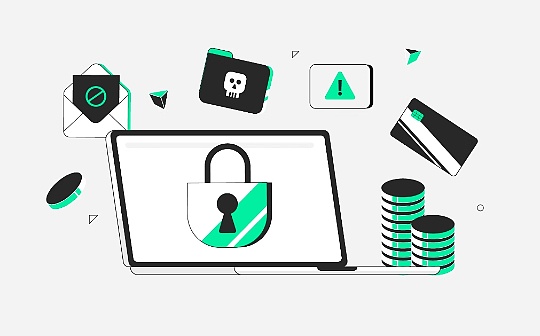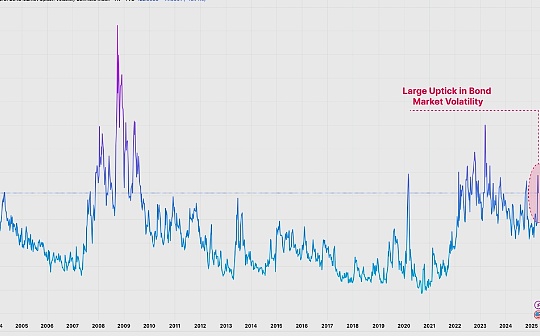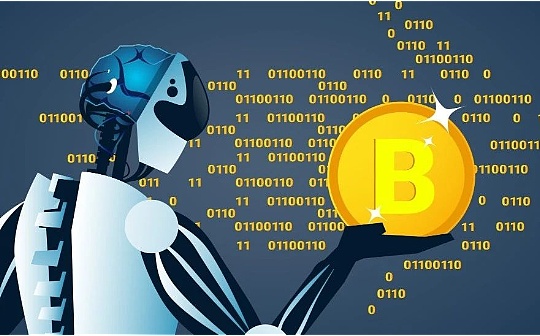
Source: GrayScale; Compilation: Songxue, Bit Chain Vision Realm
-
Recently, as the spot Bitcoin ETF was approved in the United States, Bitcoin occupied the center stage.However, the excellent performance of artificial intelligence -related crypto assets reminds people that the applicability and correlation of public blockchain use cases are expanding, surpassing the form of payment.
-
GrayScale Research believes,The development of artificial intelligence and cryptocurrencies may alleviate social problems related to artificial intelligence in the future,,For example, the rise of deep fraud, concerns about data privacy, and power concentration.
-
Although many tokens may only conform to the “artificial intelligence speculation wave”, the encryption agreement related to the development of artificial intelligence projects has obtained early signs of adoption.Specifically,The four major artificial intelligence -related cryptocurrencies calculated based on the market value [1] (TAO, RNDR, AKT, WLD) rose 522%last year, and the performance was better than the public cause and service crypto industry (+86%) at the same time.
In November last year, the six -person board of directors of OpenAI announced the replacement of the company’s chief executive officer Sam Altman, which caused a shock in the science and technology and business circles.Although this decision was later overthrown, Altman re -served as CEO, but discussions on the governance of artificial intelligence (AI) still existed, and even became a major topic at the annual meeting of the Davos World Economic Forum in Switzerland this year.
The OpenAI incident highlight the potential danger of centralized control of key technologies.For grayscale research, this leads to a key problem: how do we ensure that artificial intelligence development is accessible, competitive and transparent?Isn’t these core tenants of blockchain technology?Gray Research Company believes this, and other people in the industry have also begun to discuss similar topics.CCI’s Sheila Warren said [2], cryptocurrencies will play a key role in “checking artificial intelligence.”Similarly, the venture capitalist Fred Wilson [3] believes that artificial intelligence and cryptocurrencies are “two sides of the same coin”, and “Web3 will help us trust artificial intelligence.”
Although many cases are still in their infancy, the market seems to be optimistic about the importance of this technological cross -application.According to Coingecko network traffic,Artificial intelligence is the most popular “cryptocurrency narrative [4]” in 2023EssenceIn addition, the FTSE Russen ash encryption industry index reflects the performance advantages of some encrypted assets related to artificial intelligence compared to the public cause and service industry, as well as the entire encrypted ecosystem (Figure 1).
In this report, we try to explain the progress of artificial intelligence and encryption technology in the following fields:Verify content authenticity, reduce model deviations, and improve access and competition in artificial intelligence development.
Figure 1: The performance of large AI tokens in 2023 is better than various cryptocurrencies industries
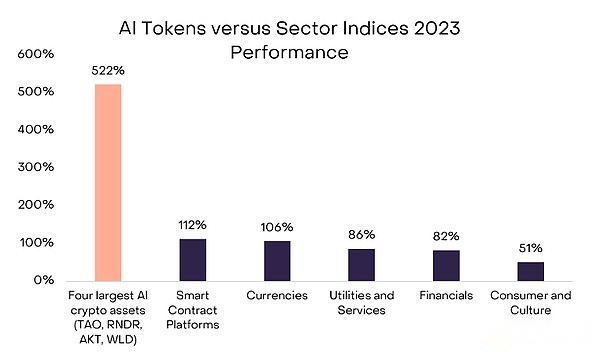
Authentication content authenticity
An artificial intelligence intensifying social issues are the flood of robots and false information.This is particularly related in the next few months, because top artificial intelligence experts are worried that deep forgery videos will try to affect the 2024 US presidential election [5].Public blockchain and its transparent and tampered ledger’s inherent characteristics provide potential solutions to respond to this broader threat.
An important measure dedicated to solving this problem is a name calledWorlddcoinEncryption protocol.Founded by SAM Altman, WorldCoin’s goal is to register everyone around the world through biological characteristics to verify that humans and robots are divided into regional.The WorldCoin team has been actively dealing with its ambitious pursuit.Since its launch about six months ago, WorldCoin has registered 2.9 million people around the world [6].In addition, last December, WorldCoin announced that it was seeking an additional 50 million US dollars private financing to expand [7].
Another measure to solve this problem is the traceability record of the digital content (DCPR) Standard, first created by the Arweave and Bundlr team.The DCPR standard uses Arweave blockchain to perform timestamps and verification of digital content, providing reliable metadata to help users evaluate the credibility of digital information [8].
Reduce the deviation in artificial intelligence models
As the artificial intelligence model increasingly integrates into our daily life, people are increasingly worried about excessive relying on these systems and their inherent prejudices.Consider such a scene, that is, a chat robot driven by artificial intelligence may affect the choice of consumers by promoting consumers to tilt or support specific political beliefs.Similarly, this technology may show prejudice that affects the population characteristics of candidates in the employment screening.As a result, the collapse of trust brings a chain effect.According to a study, the “AI detector” itself may have prejudice to the natural writing of non -English mother tongue.
BittersorA novel decentralized network, trying to solve the problem of artificial intelligence prejudice by inspiring diverse pre -training model competitions, the verifier rewarded outstanding models and eliminated poor performance and prejudice models.By cultivating open and collaborative artificial intelligence innovation environment between various models and data sets, Bittensor may promote the development of artificial intelligence and try to reduce the negative impact of prejudice [9].
Although the development of Bittensor is still in the initial stage, this decentralized network has made preliminary progress on the 32 sub -networks of special uses, including chat robots, image generation, price prediction and language translation. [10].It is worth noting that in the short term after the conflict of the OpenAI leadership, the prices of Bittensor and the two other two largest market value -related encrypted assets have risen significantly (Figure 2).We believe that this may show that the market believes that these assets may be the potential means of centralized risks brought by major artificial intelligence companies.
Figure 2: Since OPENAI has made significant progress, crypto assets related to artificial intelligence have performed well
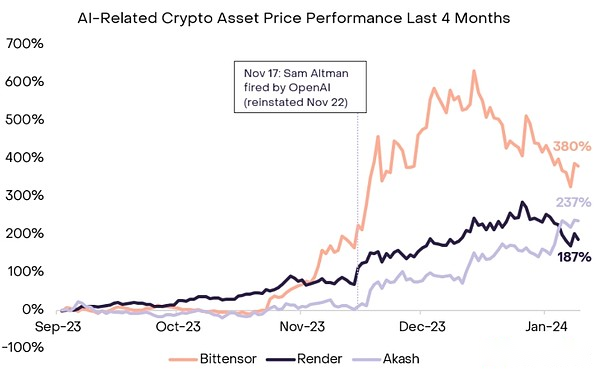
Improve the opportunity to develop artificial intelligence and exacerbate competition
In addition to the risk of model prejudice, another concern of artificial intelligence is its development.With the growth of the scale of artificial intelligence models, high costs related to computing and storage threatening to exclude competition outside, so that artificial intelligence development is mainly in the hands of a few technology giants that can afford it [11].In the past year, the increase in demand for artificial intelligence and computing resources has caused large -scale computing service providers to limit the availability of GPUs (special processors required for artificial intelligence development) [12], although there is an excess computing power [13]Essence
Decentralization calculation market, such asAkashandRenderThe design purpose is to solve the problem of inefficient use of GPU resources, and connect the GPU owner to the artificial intelligence developer seeking computing power.The system allows global individuals and organizations to realize its idle computing resources.At the same time, it provides flexible computing resource access for artificial intelligence developers.Because the blockchain eliminates the middlemen who pursue profits and expenses, these networks can provide services with a small part of the cost provided by centralized giants (such as about one -fifth of the costs provided by Akash [14]).
For example, last fall, a student at a Columbia University tried to develop artificial intelligence, but it was difficult to obtain computing resources through Amazon network services. On the contrary, he rented the GPU through AKASH, only $ 1.10 per hour [15].
Recently, some of these decentralized markets have received preliminary attention.For example, since the launch of GPU deployment in September, Akash has grown to more than 70 active GPU leasing [16].It is worth noting that the organization that provides one of its idle GPU computing resources on AKASH is Foundry [17], one of the largest encrypted mining companies.In addition, Render, a GPU market for 3D image rendering, has experienced a substantial increase in usage in 2023. [18]
Figure 3: Improve the GPU utilization of Akash, a decentralized market [19]
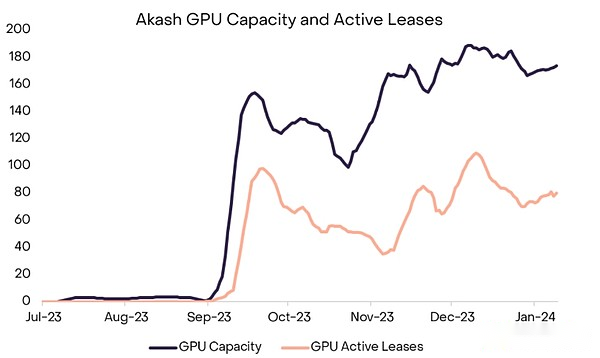
in conclusion
Today, most of the progress in this cross -field occurred in the context of the encryption agreement that helps to achieve artificial intelligence development through the decentralized GPU market.Other opportunities may exist in the following areas:
Zero knowledge proof verification of the integrity of the output of artificial intelligence modelAnd confirmed that it was generated based on the data set it claimed [20].Encryption as a payment trackRealize seamless automation and interaction with artificial intelligence agents [21].Use artificial intelligence generated in encrypted gamesAnd virtual existence as a non -quality tokens (NFT).This synergy is still in the initial stage, but it shows signs of accumulating motivation in 2024 and later, especially if market participants continue to regard these assets as one of the consolidation of large centralized participants like OpenAi in the future.Balanced means.Regardless of whether artificial intelligence and encryption are essentially related to each other, these two rapidly developing technologies have the potential to support each other’s growth in terms of use and more public correlation.
Reference information
[1] AI is adjacent to each of these tokens to play a role in encouraging the development of artificial intelligence or solving the problems related to artificial intelligence.
[9]
[10]>”>> “>>”>> “>>”>> “>MESSARI
[11]>>>>>>>>>>>>>>>>>>>>>>>>>>>>>>>>>>>>>>>>>>>>>>>>>>>>>>>>> for “>>>>Ctech
[12]>> “>>>>>>>>>>>>>>>>>>>>>>>>>>>>>>>>>>>>>>>>>>>>>>>>>>>>>>>>>>>>>>>>>>>>>>> for”>MESSARIAs well asThe information
[14]As of January 17, 2024.
[16]>>>>>>>>>>>>>>>>>>>>>>>>>>Akash.network
[19]The chart is based on the 7 -day moving average.The date range is from the GPU to the platform to the present.




